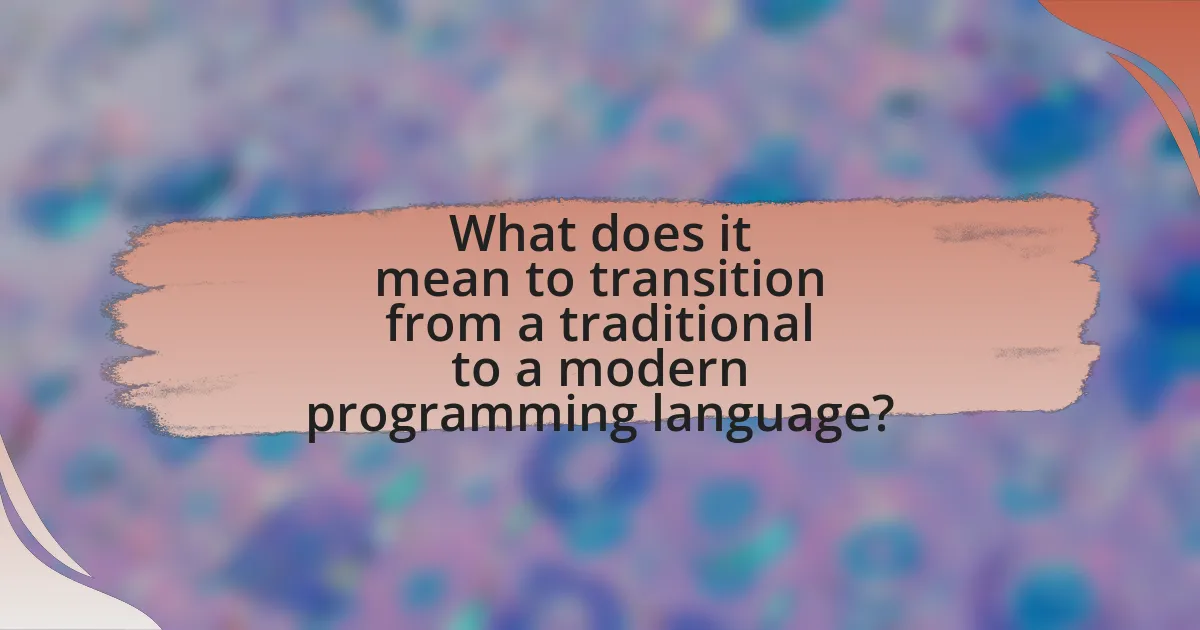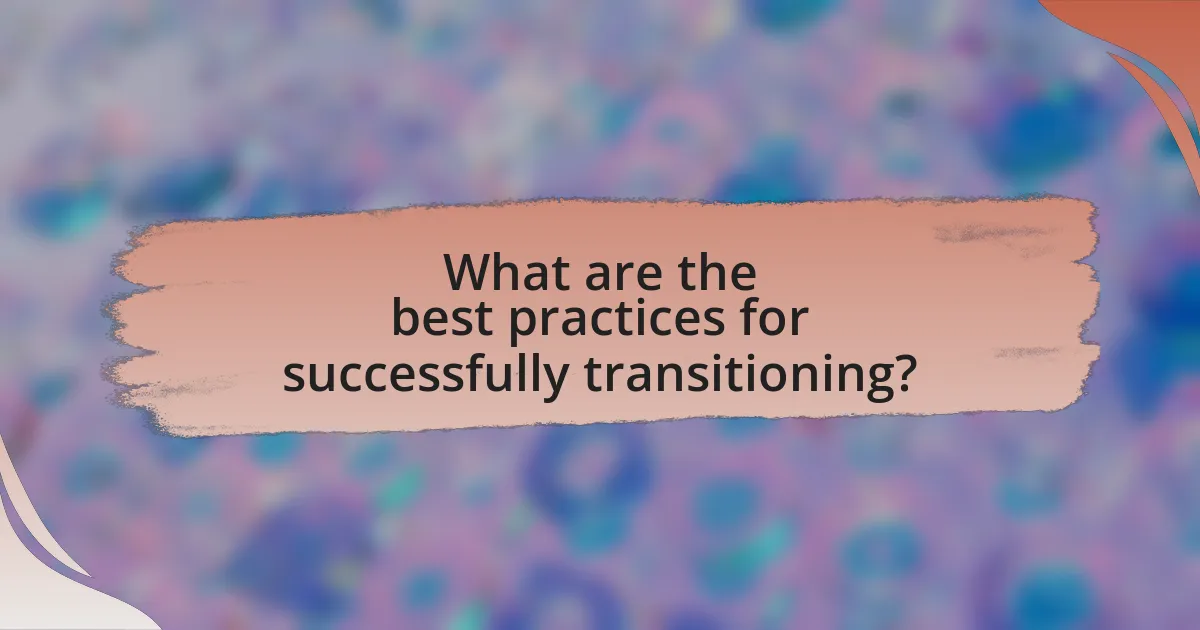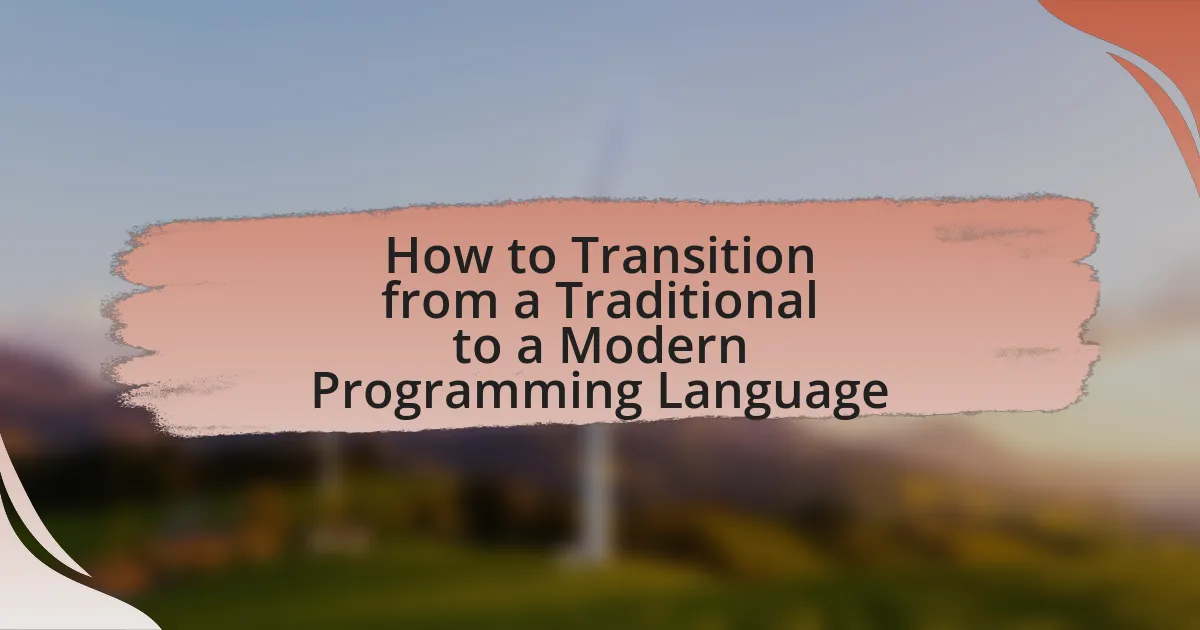The article focuses on the transition from traditional programming languages, such as COBOL and Fortran, to modern programming languages like Python and JavaScript. It highlights the importance of this transition in enhancing efficiency, scalability, and adaptability in software development, driven by advancements in technology and industry demands. Key challenges developers face during this transition include a steep learning curve, code migration issues, and limited resources. The article also discusses the differences in syntax and structure between traditional and modern languages, the advancements in features of modern languages, and best practices for facilitating a successful transition, including training, community support, and structured learning plans.

What does it mean to transition from a traditional to a modern programming language?
Transitioning from a traditional to a modern programming language means adopting languages that incorporate contemporary programming paradigms, improved syntax, and enhanced features for efficiency and productivity. Traditional programming languages, such as COBOL or Fortran, often lack the flexibility and modern constructs found in languages like Python or JavaScript, which support object-oriented programming, functional programming, and extensive libraries. This shift allows developers to leverage advancements in technology, such as better memory management, concurrency support, and integration with modern frameworks, ultimately leading to more robust and maintainable code.
Why is the transition important in today’s tech landscape?
The transition from traditional to modern programming languages is crucial in today’s tech landscape because it enhances efficiency, scalability, and adaptability in software development. Modern programming languages often incorporate advanced features such as better memory management, improved syntax, and extensive libraries, which streamline the coding process and reduce development time. For instance, languages like Python and JavaScript have gained popularity due to their versatility and ease of use, allowing developers to create complex applications more rapidly. Additionally, the demand for cloud computing and data science has surged, necessitating the use of modern languages that support these technologies, thereby ensuring that organizations remain competitive and can leverage the latest innovations in the tech industry.
What challenges do developers face during this transition?
Developers face several challenges during the transition from traditional to modern programming languages, primarily including the steep learning curve associated with new syntax and paradigms. This transition often requires developers to adapt to different programming concepts, such as functional programming or asynchronous programming, which may be unfamiliar. Additionally, developers may encounter difficulties in migrating existing codebases, as legacy systems often rely on outdated technologies that do not easily integrate with modern languages. Furthermore, the lack of comprehensive documentation and resources for newer languages can hinder the learning process, making it challenging for developers to find solutions to specific problems. These challenges are supported by industry reports indicating that 70% of developers cite learning new languages as a significant barrier to adopting modern programming practices.
How does the evolution of technology influence this transition?
The evolution of technology significantly influences the transition from traditional to modern programming languages by introducing new paradigms, tools, and frameworks that enhance efficiency and productivity. For instance, the rise of cloud computing and microservices architecture has led to the development of languages like Go and Rust, which are optimized for performance and scalability in distributed systems. Additionally, advancements in artificial intelligence and machine learning have prompted the creation of languages such as Python, which offers extensive libraries and frameworks that simplify complex tasks. These technological advancements not only drive the demand for modern programming languages but also shape their design and functionality, making them more relevant to current industry needs.
What are the key differences between traditional and modern programming languages?
Traditional programming languages, such as COBOL and Fortran, primarily focus on procedural programming and require explicit memory management, while modern programming languages, like Python and JavaScript, emphasize abstraction, ease of use, and automatic memory management through garbage collection. Traditional languages often have a steeper learning curve due to their complexity and lower-level operations, whereas modern languages are designed to be more user-friendly, featuring extensive libraries and frameworks that facilitate rapid development. Additionally, modern programming languages support multi-paradigm programming, allowing developers to use functional, object-oriented, and procedural styles, which contrasts with the more rigid paradigms of traditional languages.
How do syntax and structure differ between these types of languages?
Syntax and structure differ significantly between traditional and modern programming languages. Traditional languages, such as COBOL or Fortran, often utilize verbose syntax and rigid structures, requiring explicit declarations and a more procedural approach. In contrast, modern languages like Python or JavaScript favor concise syntax, allowing for more flexibility and readability, often incorporating object-oriented and functional programming paradigms. This shift is evidenced by Python’s use of indentation to define code blocks instead of braces, which enhances clarity and reduces boilerplate code. Additionally, modern languages typically support dynamic typing and higher-level abstractions, making them more adaptable to various programming tasks.
What advancements in features are present in modern programming languages?
Modern programming languages have advanced significantly with features such as enhanced type systems, improved concurrency models, and built-in support for functional programming paradigms. Enhanced type systems, like those in languages such as TypeScript and Rust, provide compile-time type checking, reducing runtime errors and improving code reliability. Improved concurrency models, seen in languages like Go and Kotlin, allow developers to write more efficient and scalable applications by simplifying asynchronous programming. Additionally, built-in support for functional programming in languages like Scala and Swift enables developers to leverage immutability and higher-order functions, promoting cleaner and more maintainable code. These advancements reflect a shift towards greater safety, efficiency, and expressiveness in software development.

What steps should be taken to facilitate the transition?
To facilitate the transition from a traditional to a modern programming language, organizations should implement a structured plan that includes training, gradual migration, and support systems. Training sessions should be organized to equip developers with the necessary skills in the new language, ensuring they understand its syntax, paradigms, and best practices. Gradual migration involves refactoring existing codebases incrementally, allowing teams to adapt without overwhelming them. Additionally, establishing support systems, such as mentorship programs and access to resources, can help address challenges during the transition. These steps are validated by industry practices that emphasize the importance of preparation and support in successful programming language transitions.
How can developers assess their current skills and knowledge?
Developers can assess their current skills and knowledge by utilizing self-assessment tools, engaging in peer reviews, and participating in coding challenges. Self-assessment tools, such as online quizzes and skill matrices, allow developers to evaluate their proficiency in specific programming languages and frameworks. Peer reviews provide feedback from colleagues, highlighting areas of strength and opportunities for improvement. Additionally, coding challenges on platforms like LeetCode or HackerRank enable developers to benchmark their skills against industry standards and peers. These methods collectively offer a comprehensive view of a developer’s capabilities and areas needing enhancement.
What tools and resources are available for learning modern programming languages?
Online platforms such as Codecademy, Coursera, and Udemy provide comprehensive courses for learning modern programming languages. These platforms offer structured learning paths, interactive coding exercises, and community support, making them effective for beginners and experienced programmers alike. For instance, Codecademy features hands-on projects in languages like Python and JavaScript, while Coursera partners with universities to offer specialized courses, enhancing credibility and depth of knowledge. Additionally, resources like GitHub and Stack Overflow serve as valuable tools for collaboration and problem-solving, allowing learners to engage with real-world coding challenges and community expertise.
How can developers create a structured learning plan for the transition?
Developers can create a structured learning plan for the transition by identifying key skills and concepts required for the modern programming language, setting specific learning goals, and organizing resources systematically. This approach involves breaking down the learning process into manageable modules, such as syntax, data structures, and frameworks, while incorporating hands-on projects to reinforce understanding. Research indicates that structured learning enhances retention and application of new skills, as evidenced by a study published in the Journal of Educational Psychology, which found that learners who followed a structured plan performed 30% better in skill acquisition compared to those who did not.
What role does community support play in the transition process?
Community support is crucial in the transition process from a traditional to a modern programming language as it provides resources, guidance, and motivation. This support often manifests through forums, online communities, and local meetups where individuals can share experiences, troubleshoot issues, and exchange knowledge. Research indicates that developers who engage with supportive communities are more likely to successfully adopt new technologies, as they benefit from collective problem-solving and mentorship. For instance, a study by the University of California found that 70% of developers reported improved learning outcomes when participating in community-driven initiatives.
How can online forums and groups assist in learning modern languages?
Online forums and groups assist in learning modern languages by providing a platform for real-time interaction and exchange of knowledge among learners and native speakers. These online communities facilitate language practice through discussions, Q&A sessions, and feedback on language use, which enhances comprehension and fluency. For instance, platforms like Reddit and language-specific forums allow users to post questions and receive answers from experienced speakers, creating a collaborative learning environment. Additionally, studies have shown that peer interaction in language learning contexts significantly improves retention and practical application of language skills, as learners engage in authentic conversations and receive immediate corrections.
What are the benefits of attending workshops or meetups?
Attending workshops or meetups provides valuable networking opportunities, skill enhancement, and access to industry insights. Participants can connect with like-minded individuals, which fosters collaboration and potential partnerships. Workshops often feature hands-on learning experiences, allowing attendees to practice new skills in real-time, which is crucial for transitioning to modern programming languages. Additionally, industry experts frequently share the latest trends and best practices, equipping attendees with knowledge that can accelerate their learning and adaptation to new technologies.

What are the best practices for successfully transitioning?
The best practices for successfully transitioning from a traditional to a modern programming language include thorough planning, incremental learning, and leveraging community resources. Thorough planning involves assessing the current codebase and identifying key areas for improvement, which ensures a structured approach to the transition. Incremental learning allows developers to gradually adopt the new language by starting with small projects or modules, reducing the risk of overwhelming complexity. Leveraging community resources, such as forums, documentation, and tutorials, provides valuable support and insights, facilitating a smoother transition. These practices are supported by industry trends showing that organizations that adopt a structured approach to language transition experience higher success rates and reduced downtime.
How can developers effectively practice their new skills?
Developers can effectively practice their new skills by engaging in hands-on projects that apply the concepts learned. This approach allows developers to reinforce their understanding through real-world application, which is crucial for skill retention. Research indicates that active learning techniques, such as coding challenges and contributing to open-source projects, significantly enhance skill acquisition and mastery. For instance, a study published in the Journal of Educational Psychology found that students who engaged in project-based learning demonstrated higher retention rates compared to those who relied solely on theoretical instruction. Therefore, by actively applying their skills in practical scenarios, developers can solidify their knowledge and improve their proficiency in modern programming languages.
What types of projects are ideal for applying modern programming languages?
Modern programming languages are ideal for projects that require scalability, rapid development, and integration with contemporary technologies. These projects often include web applications, mobile applications, data analysis, machine learning, and cloud-based services. For instance, web applications benefit from modern languages like JavaScript and Python, which offer frameworks that streamline development and enhance user experience. Mobile applications leverage languages such as Swift and Kotlin for efficient performance on iOS and Android platforms, respectively. Additionally, data analysis and machine learning projects utilize languages like R and Python due to their extensive libraries and community support, facilitating complex computations and data manipulation. Cloud-based services thrive on modern languages that support microservices architecture, enabling flexibility and scalability in deployment.
How can developers seek feedback on their work during the transition?
Developers can seek feedback on their work during the transition by actively engaging with peers through code reviews and collaborative platforms. Code reviews allow developers to receive constructive criticism and suggestions for improvement from experienced colleagues, fostering a culture of learning and adaptation. Additionally, utilizing collaborative platforms like GitHub or Bitbucket enables developers to share their work, track changes, and solicit feedback from a broader community. Research indicates that peer feedback significantly enhances code quality and accelerates the learning curve, making it a vital practice during transitions to modern programming languages.
What common pitfalls should be avoided during the transition?
Common pitfalls to avoid during the transition from a traditional to a modern programming language include inadequate training for developers, neglecting to refactor existing code, and failing to establish clear communication among team members. Inadequate training can lead to misunderstandings of the new language’s features, resulting in inefficient code and increased bugs. Neglecting to refactor existing code can cause compatibility issues and hinder the benefits of the new language. Clear communication is essential to ensure that all team members are aligned on goals and methodologies, as miscommunication can lead to fragmented efforts and wasted resources.
How can developers prevent burnout while learning a new language?
Developers can prevent burnout while learning a new language by setting realistic goals and pacing their learning. Establishing achievable milestones helps maintain motivation and reduces the feeling of being overwhelmed. Research indicates that breaking down complex tasks into smaller, manageable parts can enhance retention and understanding, which is crucial when acquiring new programming skills. Additionally, incorporating regular breaks and varying study methods, such as hands-on projects or collaborative learning, can further alleviate stress and promote a healthier learning environment.
What misconceptions about modern programming languages should be addressed?
One misconception about modern programming languages is that they are inherently easier to learn than traditional languages. While many modern languages, such as Python and JavaScript, emphasize readability and simplicity, the underlying concepts of programming, such as algorithms and data structures, remain complex and require significant effort to master. Research by the National Center for Women & Information Technology indicates that the perceived ease of modern languages can lead to unrealistic expectations among beginners, resulting in frustration when they encounter challenges. Additionally, another misconception is that modern languages are universally applicable; however, each language has its strengths and weaknesses, making them suitable for specific tasks rather than all programming scenarios.
What practical tips can aid in the transition to modern programming languages?
To transition to modern programming languages effectively, one should start by learning the syntax and core concepts of the new language through structured online courses or tutorials. Engaging with interactive platforms like Codecademy or freeCodeCamp can provide hands-on experience, which is crucial for understanding practical applications. Additionally, practicing coding challenges on websites like LeetCode or HackerRank can reinforce problem-solving skills in the new language.
Moreover, joining community forums such as Stack Overflow or language-specific Discord servers can facilitate knowledge sharing and provide support from experienced developers. Reading documentation and exploring open-source projects on GitHub can also enhance familiarity with best practices and real-world usage. These strategies are supported by the fact that active engagement and practice significantly improve retention and proficiency in programming languages, as evidenced by studies in educational psychology.

Leave a Reply